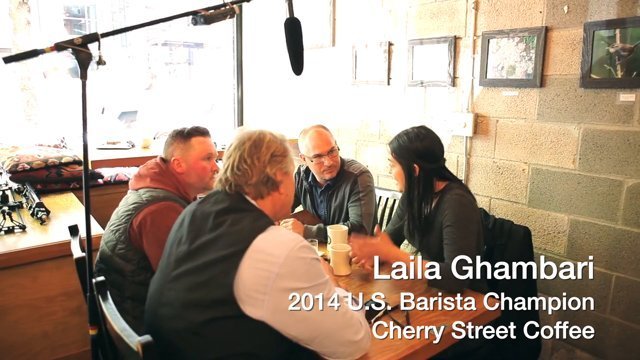
Coffee educators pen The Successful Coffee House, to be released in June 2015, bring the book to life as a seminar and workshop at upcoming Coffee Fest events
By Jeremy Martin
SPECIAL TO BARISTA MAGAZINE
Café owners are a diverse bunch. Granted, they often share a number of commonalities, such as a passion for coffee and community. But much like the businesses they run, no two coffee entrepreneurs are exactly alike.
Some enter the ownership world with years of experience as a barista or roaster in someone else’s coffee business, while others are motivated to open a café by a coffee passion they honed as a consumer, and perhaps a desire to escape a more corporate career.
These varied backgrounds make for a colorful café landscape for customers, but for those looking to existing cafés for a blueprint for how to open a coffeehouse themselves, they can often be more confusing than referential.
œIn all there is very little in terms of guidance or information to help an owner who has put in all that work, gotten up so early, dealt with equipment breaking down, and all the pain and suffering ”as well as the joy ”you go through in owning a coffeehouse, says Lon LaFlamme, director of marketing for Dillanos, a wholesale coffee roaster in Sumner, Washington.
That’s is about to change, however: Lon, along with Dillanos’ CEO David Morris, and president and COO, Chris Heyer, have recently complied the most comprehensive manifesto on creating and maintaining a functional, profitable, and, in the end, enjoyable coffeehouse experience and business.
This book, The Successful Coffee House, brings together the authors’ nearly five decades of combined coffee experience, with content ordered and organized into an easy-to-follow guideline, which, combined with some good old fashioned hard work, promises readers success in future coffee business ventures. The book will be released in June.
œThis book in many ways is dedicated to holistic branding, says Lon. œEmbracing all of the senses and all of it contributes to the cultural atmosphere and the vibe of that environment.
Environment is a running theme in the book. Creating a space that is altogether exciting, welcoming, and evolving are key aspects to customer retention. However, environment, as Lon explains, goes beyond wall adornments, music, and retail displays (though all of those are important and discussed in the book) ”it extends to creating bonds with your customers and making sure that no one leaves your café a stranger.
œIf you have 80-percent best practices and 20-percent your own invention of things the community and neighborhood embrace ”architecturally, cause wise, and so forth, and you adopt the ultimate mantra that nobody enters and leaves a stranger….you will be successful, Lon says.
The ‘best practices’ are laid out, both in the authors’ ideals for a café as well as through case studies of successful shops.
According to the book, understanding where to make improvements is just one step in guiding a quality operation, and it’s not even the first step.
Understanding the temperament and personality of your café is the initial rung in the ladder leading to long-term success.
œFirst of all, you need to understand what your culture is ”as an owner, you don’t necessarily know what it is. You need to find out through outside eyes, Lon explains.
Dillanos, for example uses a periodic Cultural Audit to access the health and environment of the cafés it supplies. The audit takes into account café atmosphere, drink preparation, music levels, store layout, and design, as well as barista and customer interaction.
œBaristas have habits that have been formed over many years, and to their credit are often focusing on perfect preparation and presentation. Complementing that needs to be experiential retail, as opposed to transactional retail, Lon says. What he means by that is not simply seeing the customer as a number, but as a neighbor to develop a relationship with.
The Successful Coffee House also lays out three styles of cafés, how they differ, and how using aspects of each can help transform an average shop into a superior one.
œIdentified in the book is the craft coffeehouse, as referenced above by being notable for perfect preparation and presentation, Lon explains. œThen there’s the classic coffeehouse, which is more experiential. It is inconsistent in its presentation and doesn’t have the barista training or dedication to perfect preparation or presentation. And then there’s the corporate or chain places, which are super automatic and almost fully transactional.
Lon, who in December will be retiring from Dillanos to pursue a future in independent consulting, has worked with other leaders in the specialty-coffee industry, including 2014 United States Barista Champion Laila Ghambari; Jack Groot, founder of JP’s Coffee and Espresso Bar; Bryan Reynolds of Anthem Coffee and Tea; and Joe Lloyd, founder of Durango Joes, to create a two-day seminar on café development and ownership, which will be offered at the Coffee Fest trade shows in Chicago (June 5 “7), Portland, Ore. (October 23 “25), and New York (March 11 “13, 2016).
The Successful Coffee House: The Definitive Seminar for the Specialty Coffee Retailer from Dillanos Coffee Roasters on Vimeo.
œAll of the speakers are ready in their careers to also consult, says Lon. œIt’s perfect timing. Everything discussed in the book isn’t in the seminar, but most of the key ingredients on what you need to do to be profitable are touched on.
The book, which comes with a study guide, will be available for sale through retailers, online at Amazon, and through the Dillanos website in June.
For information on the Coffee Fest seminar, which costs $299 per session, please visit: http://www.coffeefest.com/SCBS/SCBS.aspx


